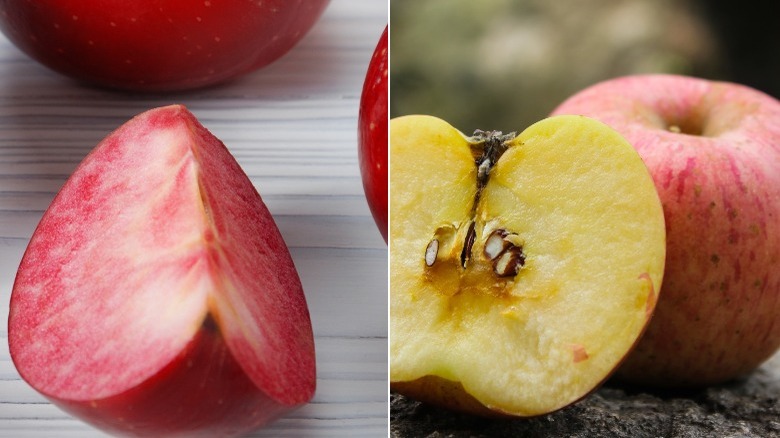What Makes Firecracker Apples Unique
Type Firecracker apple into YouTube and you'll be met instantly with several underwhelming yet amusing videos of people blowing up apples with firecrackers. Could we ask more from the internet? What you won't find is a video explaining what Firecracker apples actually are, which is why we're here to tell you what they're all about.
The name may sound fake, but rest assured, Firecracker apples are very much a real fruit. There are even two different types of them. One is a small, well-established, red-fleshed crabapple. The other Firecracker breed is a relative newcomer and was developed by Cornell University's College of Agricultural and Life Sciences (CALS), one of the country's oldest, most prestigious apple breeding programs. Apples are an essential fruit of the culture of America's northeastern states, particularly New York, where Governor Peter Stuyvesant is said to have planted one of the state's first apple trees back in 1647 (per The Jentsch Lab). The Firecracker varietals are very much a part of this heritage.
A tale of two firecrackers
Americans have tired of settling when it comes to apples, and institutions like CALS remind them they don't have to. Though they surely have their fans, easily bruised varieties with grainy flesh have been overtaken by crisper and juicier apple types. CALS has produced no less than 70 different apple varieties since 1880, and it dropped three new breeds in September of 2020, the Cordera (NY56), Pink Luster (NY73), and Firecracker (NY109) (via Cornell CALS). These fledgling varieties were explicitly designed for growers to target the modern apple consumer, who wants complex flavors and just the right crunch. For its part, the Firecracker stands out, cracking the trifecta of being suitable for eating, baking, and cider-making.
Another apple also takes the name Firecracker, but it's officially known as Bill's Red Flesh Crab. According to Adam's Apples, these are a variety of crabapples whose skin and flesh are deep red. These plucky little apples are a far cry from the Cornell variety, but the vibrancy of the Red Flesh Crab's color instantly conjures images of exploding firecrackers.
The flavor and color of Firecracker apples
Adam's Apples swoons over the CALS-developed Firecracker saying, "Its handsome red blush, streaky, russet-blasted, and set off by distinctive light lenticel dots, is complex and pleasing." The apple's size ranges from medium to large, and it has a firm yet grainy flesh that bursts with juice when eaten. The flavor of this Firecracker is a mix of sweetness and acidity, with hints of spice and yeast.
Though the Red Flesh Crab's name clearly advertises what you'll see when you cut into it, it is still a novelty since consumers have come to expect apple innards to be pale yellow. Outwardly resembling something like a mini Red Delicious, these small apples are packed with a sweet, tart taste. Its distinct flavor is a mix of cherry and grapefruit with hints of tannins, nuts, and a bit of black pepper, which is likely how it acquired the moniker, Firecracker.
Firecracker uses
As mentioned, the CALS-developed Firecracker is a triple threat in the market, and one of those is being suitable as a cider. Craft and hard ciders are having something of a moment, and this breed may just ride that wave. Interest in hard cider has increased significantly in the last few years. According to The Guardian, craft ciders are on the rise, and in early 2022, the regional market share for cider was at 51%, growing from 29% in just four years via Nielsen's recent cider market review.
For the Red Flesh Crab, its pickings vis-a-vis culinary use are a bit slimmer. Though their tartness and blend of flavors make the crabapples good for juice or cider, they don't appear to be common in recipes. One Green World notes that they are great for salads and desserts, but don't forget you can make applesauce or just eat it straight.



